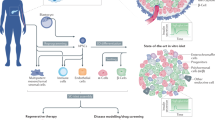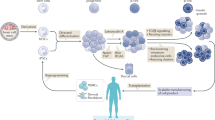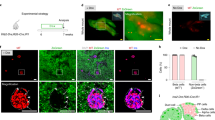Abstract
Two major initiatives are under way to correct the β-cell deficit of diabetes: one would generate β-cells ex vivo that are suitable for transplantation, and the second would stimulate regeneration of β-cells in the pancreas. Studies of ex vivo expansion suggest that β-cells have a potential for dedifferentiation, expansion, and redifferentiation. Work with mouse and human embryonic stem (ES) cells has not yet produced cells with the phenotype of true β-cells, but there has been recent progress in directing ES cells to endoderm. Putative islet stem/progenitor cells have been identified in mouse pancreas, and formation of new β-cells from duct, acinar and liver cells is an active area of investigation. Peptides, including glucagon-like peptide-1/exendin-4 and the combination of epidermal growth factor and gastrin, can stimulate regeneration of β-cells in vivo. Recent progress in the search for new sources of β-cells has opened promising new opportunities and spawned clinical trials.
This is a preview of subscription content, access via your institution
Access options
Subscribe to this journal
Receive 12 print issues and online access
$209.00 per year
only $17.42 per issue
Buy this article
- Purchase on Springer Link
- Instant access to full article PDF
Prices may be subject to local taxes which are calculated during checkout

Katie Ris

Katie Ris
Similar content being viewed by others
References
Writing team for the Diabetes Control and Complications Trial/Epidemiology of Diabetes Interventions and Complications Research Group. Sustained effect of intensive treatment of type 1 diabetes mellitus on development and progression of diabetic nephropathy: the Epidemiology of Diabetes Interventions and Complications (EDIC) study. JAMA 290, 2159–2167 (2003).
Shapiro, A.M. et al. Islet transplantation in seven patients with type 1 diabetes mellitus using a glucocorticoid-free immunosuppressive regimen. N. Engl. J. Med. 343, 230–238 (2000).
Robertson, R.P. Islet transplantation as a treatment for diabetes—a work in progress. N. Engl. J. Med. 350, 694–705 (2004).
Trucco, M. Regeneration of the pancreatic beta cell. J. Clin. Invest. 115, 5–12 (2005).
Bonner-Weir, S. Perspective: postnatal pancreatic beta cell growth. Endocrinology 141, 1926–1929 (2000).
Tyrberg, B., et al. Stimulated endocrine cell proliferation and differentiation in transplanted human pancreatic islets: effects of the ob gene and compensatory growth of the implantation organ. Diabetes 50, 301–307 (2001).
Zulewski, H. et al. Multipotential nestin-positive stem cells isolated from adult pancreatic islets differentiate ex vivo into pancreatic endocrine, exocrine, and hepatic phenotypes. Diabetes 50, 521–533 (2001).
Linning, K.D. et al. Redox-mediated enrichment of self-renewing adult human pancreatic cells that possess endocrine differentiation potential. Pancreas 29, e64–e76 (2004).
Gershengorn, M.C. et al. Epithelial-to-mesenchymal transition generates proliferative human islet precursor cells. Science 306, 2261–2264 (2004).
Lechner, A., Nolan, A.L., Blacken, R.A. & Habener, J.F. Redifferentiation of insulin-secreting cells after in vitro expansion of adult human pancreatic islet tissue. Biochem. Biophys. Res. Commun. 327, 581–588 (2005).
Grunert, S., et al. Diverse cellular and molecular mechanisms contribute to epithelial plasticity and metastasis. Nat. Rev. Mol. Cell Biol. 4, 657–665 (2003).
Ling, Z. & Pipeleers, D.G. Prolonged exposure of human β cells to elevated glucose levels results in sustained cellular activation leading to a loss of glucose regulation. J. Clin. Invest. 98, 2805–2812 (1996).
Hardikar, A.A., et al. Human pancreatic precursor cells secrete FGF2 to stimulate clustering into hormone-expressing islet-like cell aggregates. Proc. Natl. Acad. Sci. USA 100, 7117–7122 (2003).
Soria, B. et al. Insulin-secreting cells derived from embryonic stem cells normalize glycemia in strepotozotocin-induced diabetic mice. Diabetes 49, 157–162 (2000).
Assady, S. et al. Insulin production by human embryonic stem cells. Diabetes 50, 1691–1697 (2001).
Leon-Quinto, T., et al. In vitro directed differentiation of mouse embryonic stem cells into insulin-producing cells. Diabetologia 47, 1442–1451 (2004).
Lumelsky, N. et al. Differentiation of embryonic stem cells to insulin-secreting structures similar to pancreatic islets. Science 292, 1389–1393 (2001).
Hori, Y. et al. Growth inhibitors promote differentiation of insulin-producing tissue from embryonic stem cells. Proc. Natl. Acad. Sci. USA 99, 16105–16110 (2002).
Kahan, B.W. et al. Pancreatic precursors and differentiated islet cell types from murine embryonic stem cells: an in vitro model to study islet differentiation. Diabetes 52, 2016–2024 (2003).
Blyszczuk, P. et al. Embryonic stem cells differentiate into insulin-producing cells without selection of nestin-expressing cells. Int. J. Dev. Biol. 48, 1095–1104 (2004).
Blyszczuk, P. et al. Expression of Pax4 in embryonic stem cells promotes differentiation of nestin-positive progenitor and insulin-producing cells. Proc. Natl. Acad. Sci. USA 100, 998–1003 (2003).
Miyazaki, S., Yamato, E. & Miyazaki, J. Regulated expression of pdx-1 promotes in vitro differentiation of insulin-producing cells from embryonic stem cells. Diabetes 53, 1030–1037 (2004).
Segev, H., et al. Differentiation of human embryonic stem cells into insulin-producing clusters. Stem Cells 22, 265–274 (2004).
Rajagopal, J., Anderson, W.J., Kume, S., Martinez, O.I. & Melton, D.A. Insulin staining of ES cell progeny from insulin uptake. Science 299, 363 (2003).
Hansson, M. et al. Artifactual insulin release from differentiated embryonic stem cells. Diabetes 53, 2603–2609 (2004).
Sipione, S., et al. Insulin expressing cells from differentiated embryonic stem cells are not beta cells. Diabetologia 47, 499–508 (2004).
Kania, G., et al. The generation of insulin-producing cells from embryonic stem cells–a discussion of controversial findings. Int. J. Dev. Biol. 48, 1061–1064 (2004).
Hori, Y., Gu, X., Xie, X. & Kim, S.K. Differentiation of insulin-producing cells from human neural progenitor cells. PLoS Med. 2, e103 (2005).
Schuit, F., et al. Glucose-regulated gene expression maintaining the glucose-responsive state of beta-cells. Diabetes (suppl. 3) 51, S326–S332 (2002).
Halban, P. A., et al. Gene and cell-replacement therapy in the treatment of type 1 diabetes: how high must the standards be set? Diabetes 50, 2181–2191 (2001).
Weir, G.C. Can we make surrogate beta-cells better than the original? Semin. Cell Dev. Biol. 15, 347–357 (2004).
Hanahan, D. Peripheral-antigen-expressing cells in thymic medulla: factors in self-tolerance and autoimmunity. Curr. Opin. Immunol. 10, 656–662 (1998).
Devaskar, S.U. et al. Insulin gene expression and insulin synthesis in mammalian neuronal cells. J. Biol. Chem. 269, 8445–8454 (1994).
Alarcon, C., et al. Synthesis and differentially regulated processing of proinsulin in developing chick pancreas, liver and neuroretina. FEBS Lett. 436, 361–366 (1998).
Asahina, K. et al. Expression of the liver-specific gene Cyp7a1 reveals hepatic differentiation in embryoid bodies derived from mouse embryonic stem cells. Genes Cells 9, 1297–1308 (2004).
Kubo, A. et al. Development of definitive endoderm from embryonic stem cells in culture. Development 131, 1651–1662 (2004).
Ku, H.T. et al. Committing embryonic stem cells to early endocrine pancreas in vitro. Stem Cells 22, 1205–1217 (2004).
Dor, Y., Brown, J., Martinez, O.I. & Melton, D.A. Adult pancreatic beta-cells are formed by self-duplication rather than stem-cell differentiation. Nature 429, 41–46 (2004).
Suzuki, A., Nakauchi, H. & Taniguchi, H. Prospective isolation of multipotent pancreatic progenitors using flow-cytometric cell sorting. Diabetes 53, 2143–2152 (2004).
Seaberg, R.M. et al. Clonal identification of multipotent precursors from adult mouse pancreas that generate neural and pancreatic lineages. Nat. Biotechnol. 22, 1115–1124 (2004).
Weir, G.C. & Bonner-Weir, S. Beta-cell precursors–a work in progress. Nat. Biotechnol. 22, 1095–1096 (2004).
Bonner-Weir, S. et al. The pancreatic ductal epithelium serves as a potential pool of progenitor cells. Pediatr. Diabetes 5, 16–22 (2004).
Lardon, J., Huyens, N., Rooman, I. & Bouwens, L. Exocrine cell transdifferentiation in dexamethasone-treated rat pancreas. Virchows Arch. 444, 61–65 (2004).
Baeyens, L. et al. In vitro generation of insulin-producing beta cells from adult exocrine pancreatic cells. Diabetologia 48, 49–57 (2005).
Rooman, I., et al. Mitogenic effect of gastrin and expression of gastrin receptors in duct-like cells of rat pancreas. Gastroenterology 121, 940–949 (2001).
Rooman, I. & Bouwens, L. Combined gastrin and epidermal growth factor treatment induces islet regeneration and restores normoglycaemia in C57Bl6/J mice treated with alloxan. Diabetologia 47, 259–265 (2004).
Jensen, J.N. et al. Recapitulation of elements of embryonic development in adult mouse pancreatic regeneration. Gastroenterology 128, 728–741 (2005).
Bonner-Weir, S. et al. In vitro cultivation of human islets from expanded ductal tissue. Proc. Natl. Acad. Sci. USA 97, 7999–8004 (2000).
Gao, R. et al. Characterization of endocrine progenitor cells and critical factors for their differentiation in human adult pancreatic cell culture. Diabetes 52, 2007–2015 (2003).
Suarez-Pinzon, W.L., et al. Combination therapy with epidermal growth factor and gastrin induces neogenesis of human islet β-cells from pancreatic duct cells and an increase in functional β-cell mass. J. Clin. Endocrinol. Metab. 90, 3401–3409 (2005).
Jiang, Y. et al. Pluripotency of mesenchymal stem cells derived from adult marrow. Nature 418, 41–49 (2002).
Ianus, A., Holz, G.G., Theise, N.D. & Hussain, M.A. In vivo derivation of glucose-competent pancreatic endocrine cells from bone marrow without evidence of cell fusion. J. Clin. Invest. 111, 843–850 (2003).
Hess, D. et al. Bone marrow-derived stem cells initiate pancreatic regeneration. Nat. Biotechnol. 21, 763–770 (2003).
Mathews, V. et al. Recruitment of bone marrow-derived endothelial cells to sites of pancreatic beta-cell injury. Diabetes 53, 91–98 (2004).
Tang, D.Q. et al. In vivo and in vitro characterization of insulin-producing cells obtained from murine bone marrow. Diabetes 53, 1721–1732 (2004).
Zorina, T.D. et al. Recovery of the endogenous beta cell function in the NOD model of autoimmune diabetes. Stem Cells 21, 377–388 (2003).
Kodama, S., et al. Islet regeneration during the reversal of autoimmune diabetes in NOD mice. Science 302, 1223–1227 (2003).
Ogawa, N., et al. Cure of overt diabetes in NOD mice by transient treatment with anti-lymphocyte serum and exendin-4. Diabetes 53, 1700–1705 (2004).
Chatenoud, L., Primo, J. & Bach, J.F. CD3 antibody-induced dominant self tolerance in overtly diabetic NOD mice. J. Immunol. 158, 2947–2954 (1997).
Fujita, Y., Cheung, A.T. & Kieffer, T.J. Harnessing the gut to treat diabetes. Pediatr. Diabetes (suppl. 2) 5, 57–69 (2004).
Ferber, S. et al. Pancreatic and duodenal homeobox gene 1 induces expression of insulin genes in liver and ameliorates streptozotocin-induced hyperglycemia. Nat. Med. 6, 568–572 (2000).
Ber, I. et al. Functional, persistent, and extended liver to pancreas transdifferentiation. J. Biol. Chem. 278, 31950–31957 (2003).
Kaneto, H. et al. A crucial role of mafA as a novel therapeutic target for diabetes. J. Biol. Chem. 280, 15047–15052 (2005).
Kojima, H. et al. NeuroD-betacellulin gene therapy induces islet neogenesis in the liver and reverses diabetes in mice. Nat. Med. 9, 596–603 (2003).
Zalzman, M. et al. Reversal of hyperglycemia in mice by using human expandable insulin-producing cells differentiated from fetal liver progenitor cells. Proc. Natl. Acad. Sci. USA 100, 7253–7258 (2003).
Kaneto, H. et al. PDX-1/VP16 fusion protein, together with neuroD or ngn3, markedly induces insulin gene transcription and ameliorates glucose tolerance. Diabetes 54, 1009–1022 (2005).
Yang, L. et al. In vitro trans-differentiation of adult hepatic stem cells into pancreatic endocrine hormone-producing cells. Proc. Natl. Acad. Sci. USA 99, 8078–8083 (2002).
Cao, L.Z., Tang, D.Q., Horb, M.E., Li, S.W. & Yang, L.J. High glucose is necessary for complete maturation of Pdx1–VP16-expressing hepatic cells into functional insulin-producing cells. Diabetes 53, 3168–3178 (2004).
Bruning, J.C. et al. Development of a novel polygenic model of NIDDM in mice heterozygous for IR and IRS-1 null alleles. Cell 88, 561–572 (1997).
Butler, A.E. et al. Beta-cell deficit and increased beta-cell apoptosis in humans with type 2 diabetes. Diabetes 52, 102–110 (2003).
Rosenberg, L. et al. A pentadecapeptide fragment of islet neogenesis-associated protein increases beta-cell mass and reverses diabetes in C57BL/6J mice. Ann. Surg. 240, 875–884 (2004).
Li, L., et al. Activin A and betacellulin: effect on regeneration of pancreatic beta-cells in neonatal streptozotocin-treated rats. Diabetes 53, 608–615 (2004).
Brubaker, P.L. & Drucker, D.J. Minireview: glucagon-like peptides regulate cell proliferation and apoptosis in the pancreas, gut, and central nervous system. Endocrinology 145, 2653–2659 (2004).
DeFronzo, R.A., et al. Effects of exenatide (exendin-4) on glycemic control and weight over 30 weeks in metformin-treated patients with type 2 diabetes. Diabetes Care 28, 1092–1100 (2005).
Kendall, D.M. et al. Effects of exenatide (exendin-4) on glycemic control over 30 weeks in patients with type 2 dia betes treated with metformin and a sulfonylurea. Diabetes Care 28, 1083–1091 (2005).
Ratner, R.E., Feeley, D., Buse, J.B. & Schwartz, S.L. Double-blind, placebo-controlled trial of islet neogenesis gene associated protein (INGAP) in type 1 diabetes. Diabetes (suppl. 1) 54, 11-LB (late breaking abstract) (2005).
Ratner, R.E., Feeley, D., Buse, J.B. & Fischer, J.S. Double-blind, placebo-controlled trial of islet neogenesis gene associated protein (INGAP) in type 2 diabetes. Diabetes (suppl. 1) 54, 12-LB (late breaking abstract) (2005).
Acknowledgements
The research that provides the background for this review has been supported by the National Institutes of Health, the Juvenile Diabetes Foundation Research Foundation, the Diabetes Research and Wellness Foundation and an important group of private donors.
Author information
Authors and Affiliations
Corresponding author
Ethics declarations
Competing interests
G.C.W. in on an advisory board for Amylin, which makes exendatide (extendin 4), but does not own any Amylin stock.
Rights and permissions
About this article
Cite this article
Bonner-Weir, S., Weir, G. New sources of pancreatic β-cells. Nat Biotechnol 23, 857–861 (2005). https://doi.org/10.1038/nbt1115
Published:
Issue Date:
DOI: https://doi.org/10.1038/nbt1115
This article is cited by
-
Single-nucleus RNA sequencing of human pancreatic islets identifies novel gene sets and distinguishes β-cell subpopulations with dynamic transcriptome profiles
Genome Medicine (2023)
-
Comparative effects of curcumin versus nano-curcumin on histological, immunohistochemical expression, histomorphometric, and biochemical changes to pancreatic beta cells and lipid profile of streptozocin induced diabetes in male Sprague–Dawley rats
Environmental Science and Pollution Research (2023)
-
Chemically defined conditions for long-term maintenance of pancreatic progenitors derived from human induced pluripotent stem cells
Scientific Reports (2019)
-
Beta cells in type 1 diabetes: mass and function; sleeping or dead?
Diabetologia (2019)
-
Islet-Like Structures Generated In Vitro from Adult Human Liver Stem Cells Revert Hyperglycemia in Diabetic SCID Mice
Stem Cell Reviews and Reports (2019)



